Research projects
Keywords: interior evolution and deformation
 Courtesy NASA/JPL/SSI
Courtesy NASA/JPL/SSI
Outer solar system planets have satellites (moons) mainly composed of ice. Some of these "icy satellites" (such as the Jovian satellite Europa and the Saturnian satellite Enceladus) are likely to possess liquid parts called "subsurface oceans." Heat production due to tides is likely to play a major role in preventing such satellites from complete freezing. On the Earth, sea levels change mainly due to the effect of the Moon; icy satellites, however, do not possess surface oceans, so surface icy crusts deform. This would cause frictional heating in such solid shells.
On this tidal deformation, we focus on a resonant phenomenon. As a satellite gets colder, a subsurface ocean freezes, resulting in a thickening of an icy crust and leading to a smaller deformation amplitude. However, as the ocean gets thinner and thinner, the amplitude of deformation could increase due to a resonance. This resonance occurs when the velocity of tidal deformation approaches the phase velocity of gravity waves of the ocean. Since an enhanced deformation leads to an increase in the tidal heating rate, this resonance would be important for the evolution of icy satellites in particular for maintaining subsurface oceans.
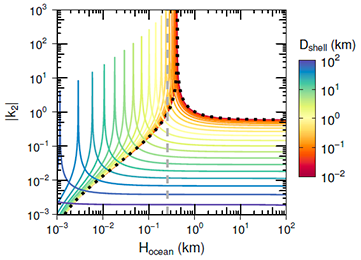
Enhanced tidal deformation due to a resonance [Kamata et al., 2015, JGR]
We also conduct research on icy satellites more directly related to a future exploring mission. In the JUICE mission led by European Space Agency, a spacecraft will orbit the Jovian icy satellite Ganymede and will measure tidal deformation from 2032. To what extent can we tell about the interior structure of Ganymede from such data? To answer this question, we need to investigate the relation between the interior structure and tidal response in detail.
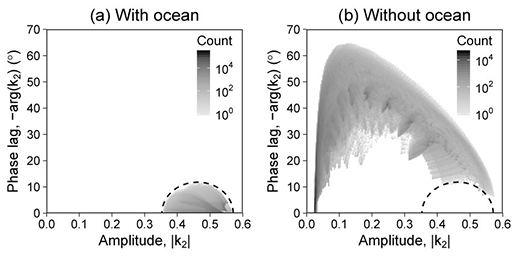
Expected amplitude and phase lag of tidal response [Kamata et al., 2016, JGR]
We consider a wide variety of interior structural models and investigate the tidal response of Ganymede. We found that measurements of phase lag in addtion to amplitude are important to infer the presence of a subsurface ocean. Also, we found that measurements of gravitational response as well as topographic response are important to reduce the error in the ice shell thickness estimation. Results obtained are provided to the JUICE team, supporting the development of an instrument onboard JUICE.
 Courtesy NASA
Courtesy NASA
The Earth's Moon is the most familiar and closest body to us, so we have a large amount of observational data. Unlike the Earth, the Moon does not have an ocean nor atmosphere. Because of this, the lunar geology has not been altered since billions of years ago. This familiar and simple Moon is a key planetary body to understand the early evolution of rocky planetary bodies.
The understanding of deformation of impact basins (large impact craters) is extremely important in order to reveal the thermal evolution of planetary bodies. If the lunar interior was hot at the time of basin formation, then the crust and mantle of the Moon was soft. Then, the circular structure of an impact basin would be relaxed; the current lunar crust would be flat. In contrast, if the lunar interior was cold at the time of impact, then we would observe a concentric pattern formed by the impact. From this point of view, we analyzed topography and gravity field data obtained by the Kaguya (SELENE) lunar explorer and constrained the paleo-thermal state of the Moon.
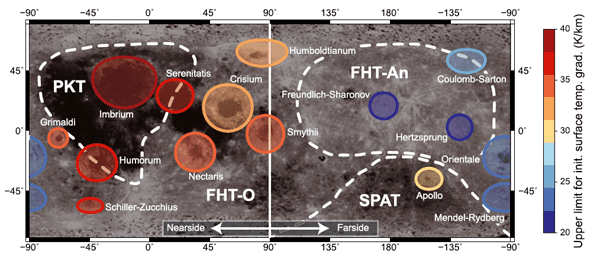
Upperbound of thermal gradient at basin formation ages [Kamata et al., 2013, JGR]
What is the most important heat source for the long-term planetary evolution? That is the heat produced by the decay of radioactive elements, such as thorium, uranium, and potassium. If the planetary interior is rich in these elements, then magmatism can continue for a long time, and mantle convection can occur vigorously. Subsurface radioactive elements are therefore play a major role in planetary evolution. It is, however, impossible to measure their concentrations in the deep interior directly. From our constraints on the early lunar thermal state, we further revealed that the lunar farside crust probably depleted in radioactive elements. Such large-scale heterogeneous distribution of radioactive elements suggests that the lunar nearside and farside experienced distinctively different evolutional histories from its early stage.
We also obtained interesting results for nearly completely relaxed impact basins. Our analysis of recent data from LRO and GRAIL and of crater relaxation simulations revealed that highly relaxed basins on the Moon formed shortly after the solidification of the Lunar Magma Ocean.
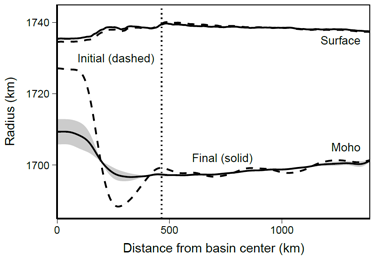
Numerical simulation of viscous relaxation of an impact basin [Kamata et al., 2015, Icarus]
The understanding of the timing and the number of large-scale impacts on the Moon is crucial to understand the history not only of the Moon but also of the early Earth and of the Solar System. Based on latest results, we are now investigating the impact history of the Solar system.
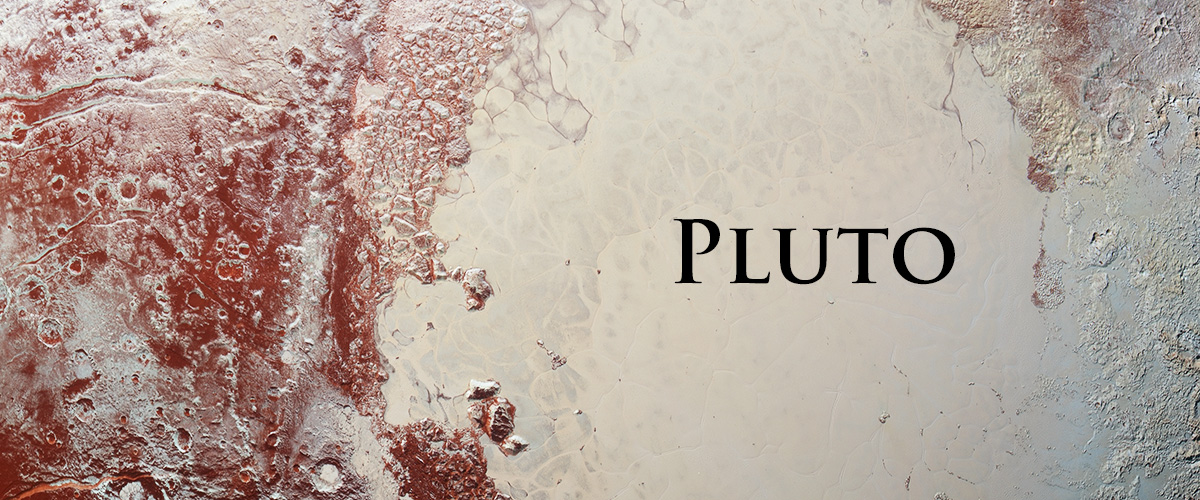 Courtesy NASA/JHUAPL/SwRI
Courtesy NASA/JHUAPL/SwRI
Pluto is a large icy body of Kuiper Belt Objects orbiting at the outer edge of the Solar System. In the summer of 2015, New Horizons visited Pluto and its satellite, Charon, and this was the first exploration of Kuiper Belt Objects. This exploration not only deepens our understanding of Pluto but also reveals many mysterious features of Pluto.
One such mystery is the presence of a thick liquid layer (subsurface ocean) beneath a solid ice layer (ice shell). Pluto is very far from the Sun and thus is very cold, and tidal heating is negligible, suggesting that Pluto's ocean has been completely solidified long ago. The second mystery is that the ice shell is locally very thin. Previous studies suggest that the ice shell would be flattened within a short time. In addition, the chemical composition of Pluto's surface is largely different from that of comets which come from Kuiper Belts, and this is another mystery of Pluto.
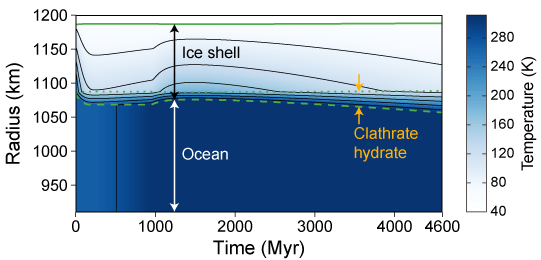
Long-term evolution simulation of Pluto [Kamata et al., 2019, Nat. Geosci.]
We successfully solved these mysteries at once. The key is gas hydrates (clathrate hydrates). Gas hydrates are solid matter mainly composed of water (H2O), and gases such as methane are trapped in cages created by water molecules. Natural gas hydrates can be found on the seafloor of terrestrial oceans and are considered to be important natural resources. We found that mysteries of Pluto can be explained if a thin gas hydrate layer exists between the ice shell and the subsurface ocean. Because thermal conductivity of gas hydrates is low, they act as a natural "thermal insulator", keeping a subsurface ocean warm for a long time. At the same time, the ice shell above this "thermal insulator" becomes cool and hard, inhibiting its deformation. Furthermore, the unique surface chemistry can be explained by the fact that some gas species are trapped in gas hydrates more easily than others.
What we found here is a new generic mechanism to maintain subsurface oceans in icy bodies. Some large icy bodies meet the criteria of gas hydrate formation, and therefore gas hydrates may also play an important role in maintaining subsurface oceans of other icy bodies. Considering this fact, we are investigating the thermal evolution of large icy satellites.
The press release of this work from Hokkaido University can be found here. This work is selected as one of Research Highlights by the publisher Springer Nature and is reported by many news media. Below are examples:
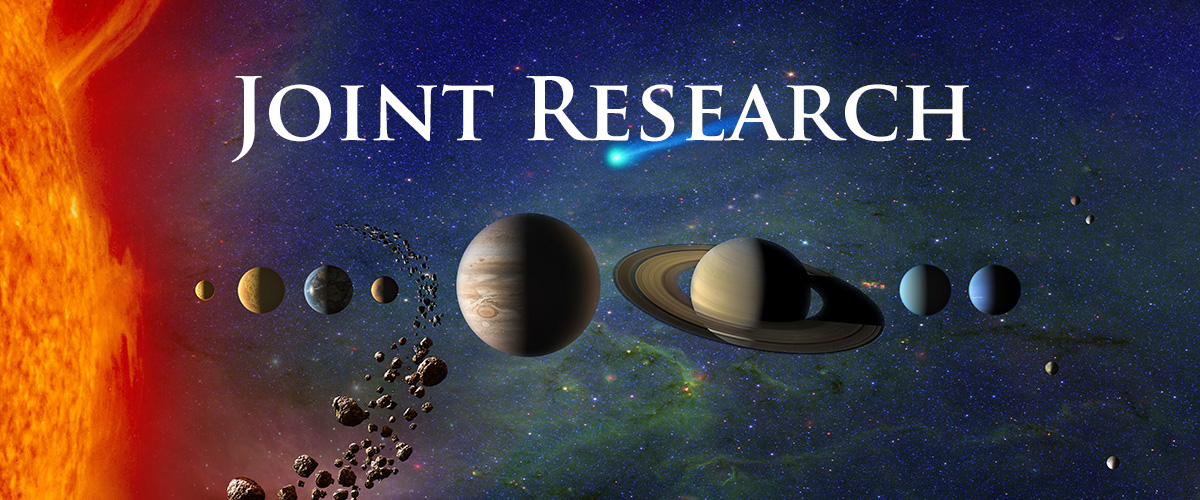 Courtesy NASA
Courtesy NASA
I am involved in many joint research projects related to planetary explorations. I operated subsatellites of the Japanese lunar explorer "Kaguya" (SELENE) and analyzed data (Same-beam VLBI) as a member of the lunar gravity field measurement team. Some of my collaborative works are: lunar geologic history studies using images taken by "Kaguya" (SELENE), spectroscopic studies of asteroidal surfaces using images taken by the Japanese asteroid explorer "Hayabusa," investigations of the evolution of Pluto based on New Horizons images, an investigation of the deep interior of the Moon using Apollo seismic data and recent geodetic data, a development of an elemental composition analyzer for future landing missions, ground observations of the impact of LCROSS on the Moon and of an asteroid 1999JU3 (Ryugu), the target body of the 2nd Japanese asteroid explorer "Hayabusa-2." In addition, I conduct numerical simulations of large-scale impacts using the iSALE shock physics code.